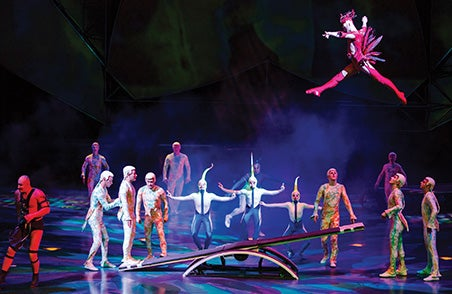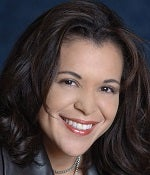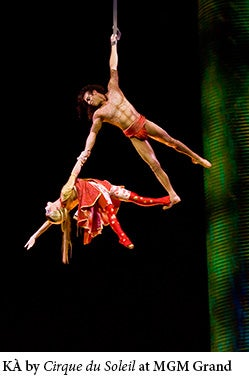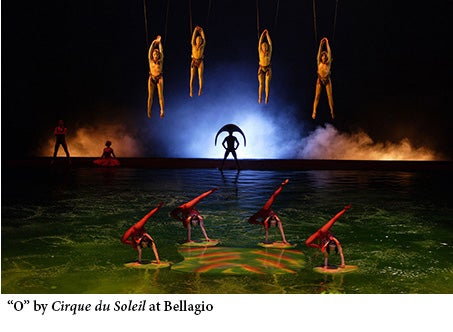Cirque du Soleil’s Alma Derricks: Marketing From ‘Angel’ To ‘Zarkana’
What does it take to market a brand for which upside down and inside out is normal? For that we turn the spotlight on Cirque’s VP of sales and marketing, Alma Derricks. “I get most excited about inflection points, like Cirque is in right now,” she said in an exclusive CMO.com Interview.

If you’ve ever been to Las Vegas, chances are you’ve seen a Cirque du Soleil show. Eight are currently being staged there, with 20 more running in cities around North America or on tour. “Mystère,” “O,” “Zarkana,” “Criss Angel: Believe,” and “Love” are just a few of the names you might recognize—or have seen.
Though the concept and brand have been around for some 30 years, it’s only recently that Cirque has taken marketing seriously—or has had to. After its recent acquisition by financial powerhouse TPG, the new-wave circus hired Alma Derricks as VP of sales and marketing, Resident Shows Division. Derricks has been around the media and entertainment block and more during her storied career at HBO, Paramount, Deloitte, and others, and she has brought her powers to bear now on Cirque.
In this exclusive interview, we find out just how she ended up joining the circus and what it takes to market a brand for which upside down and inside out is normal. And did we mention she has 25,000 seats a night to sell? (Editor’s note: Derricks will be speaking at the upcoming Adobe Summit.)
CMO.com: So how does a nice marketer like you end up running away with the circus?
Derricks: I’ve been in media and entertainment my entire career, so I’ve done the rounds through different industries. My original interest when I was a teenager was in broadcast journalism. By the time I finished college, I knew I wanted to stay in media, but I decided I really didn’t want to chase the on-air part, so I ended up in media buying, then post-production, and then went to business school. I was also an NBC Fellow at Georgetown.

All of that set me up for the combination of consulting and operating career that I’ve had. It meant that I was constantly being thrown into the deep ends of new pools, to go in and figure out how to start something up from scratch. Everything was always new, and I think that gets into your blood a little bit. So my combination of skills is partially marketing, as a classic discipline, but also very brand-driven when it comes to how you use a brand as a compass to help you understand where you go next with brand extensions and new lines of business.
CMO.com: That sounds like a career in itself—but there was still more to come before Cirque?
Derricks: Yes, indeed. I left HBO to venture out into the world of new media back in ’94. The commercial Internet was starting to bubble up–this was AOL, CompuServe, Prodigy time–and I wanted to be a part of it all, so I hung my hat out as a new media consultant and got hired by a company that has since been acquired, called United Media. United Media was a traditional newspaper syndicate but also a licensing organization, so we had the Peanuts comic strip, which was a $1 billion franchise in its heyday, and still drives quite a bit of revenue.
But the one that changed my life was Dilbert. In very short order, I suggested that we build a website, back when no one really knew what that was. I said, “We’re going to build a website, we’re going to put Dilbert on it, and we’re going to sell stuff, and we’re going to sell advertising against it. We’re going to go at it alone.” The question on the table was how to take this business—United Media—that was 50 years old at the time, take a look at the content, and migrate it into this new space. I like doing this with legacy brands, not just pure startups, where you have the history of something like a Dilbert or a Peanuts, how you morph that and take it to the next level is really something I adore, which you’ll see shades of in my role at Cirque.
This was followed by stints as vice president of the digital entertainment group at Paramount, the LA Times, Scient, and when everything crashed on the Internet in 2000 or so, I opened my own shop again and was doing my own consulting. Then Deloitte recruited me in 2008 to be a partner in the media and entertainment practice. Blue Man Group was one of my clients, which set me up perfectly for the desert and Las Vegas.
CMO.com: Which will then bring us to Cirque?
Derricks: Yes. About a year-and-a-half ago, I left to go back to my own practice, and that’s when I met the folks at Cirque, which was in the process of working with Goldman Sachs on executing the sale that eventually happened in July. They were being acquired by TPG, and I think my background on the consulting side and my familiarity with TPG is something that’s really benefitting Cirque. The larger question about how you position a media business and then how you translate that into the language of finance and the consulting view of it has been really spectacular.
The other thing I’d say about Cirque—and what drew me to it at the time and drew us to each other—is that I get most excited about inflection points, like Cirque is in right now. It’s one thing to have a role on the org chart, to take hold of marketing, but when a company is going through a sea change, I get particularly excited. Before I even met the folks at Cirque, when people would ask me, “Are you looking for a new thing or looking for a new job?” I said, “I’m not looking for a role; I’m looking for a moment in time.” I used to use LEGO as an example. At some point at LEGO, somebody somewhere said, “You know, we should do a theme park”—that’s the a-ha moment. And I magically found that with Cirque and with my team in Las Vegas. It’s been phenomenal and feels like a much longer ride than six months.
CMO.com: The other brands you worked with all had some kind of a story or property that you could bring to the Web. Here’s something that only exists in its performance. How do you work on bringing that to the digital world?
Derricks: I think it’s fair to say, just to broaden the point, that not only was digital marketing new, but marketing was relatively new—very sales-driven, very promotions-driven—but Cirque just needed to say they were coming to town, and you couldn’t get tickets. So there was a long blessed period of time where Cirque grew of its own accord just because it was so new, so unusual, so entertaining, and so exquisite that there would have been no time to market in a case like that. What do you do to market a show that’s sold out perpetually?
It’s true that we weren’t there at the dawn of the Internet, and we weren’t one of the first companies to the party when it comes to digital and social. We’re starting to do more now with wearable cams and video behind the scenes and backstage footage. There’s so much that goes into what we present. Fans want to go behind the scenes; they want to see behind the curtain; they want different viewpoints and perspectives. It’s also thinking about each show differently when you come to it physically. What kinds of backstage tours or experiences can I give you to see the show from an entirely other perspective?
One of the things about digital that has remained true for 20 years is the fact that the kind of ravenous interest in going behind the scenes and understanding those things doesn’t spoil the magic trick at all. In fact, it sort of heightens it.
CMO.com: That’s an interesting point—that it heightens the experience. So live performance has a place on the Web when done right?
Derricks: Certainly. I mean, look at what’s happened with Coachella and Burning Man and these things that were very small music festivals. The media that we’ve all lived through in the past 20 years has made live experiences that much richer and interesting. You could argue that seeing a Cirque show is difficult to capture on camera. And yet we’ve got so many different ways to access the product. We’ve got so many talented people. We can give you a view of what it looks like to be on a skateboard, trampoline, or trapeze. These are incredible human achievements. That piece of it is what brings people back, regardless of how much access to content you have. These kinds of live experiences, just like concerts, just like sporting events, become that much richer because you were there.

CMO.com:In the marketing of Cirque, do you separate the brand, content, marketing, and storytelling side from the getting-butts-in seats side?
**Derricks:**As we do marketing in digital, it’s still more the equivalent of the music video to the concert. Our efforts in that space will always be a taste test of the thing that is the live show. And having come from traditional media, it’s one of the things that’s liberating, that we use media as a gateway, as a way to tell our story, as a way to present our performers, as a way to share trailers, essentially, of what the experience is. But the experience is still something that’s live and in person–whether it’s in Las Vegas or in a tent. So we can be a little more liberal and a little more generous with what we give away in digital or in traditional media, for that matter, because it never is a replacement for the actual experience of going out.
It’s much tougher to be in a traditional media business these days, where your business is dependent on attracting attention in an increasingly crowded marketplace, whether it’s to sell advertising or to sell a subscription or to sell content itself. All of those things are just becoming more and more difficult. As tough as it is for me to put butts in seats every night–we have 25,000 seats just in Las Vegas a night–Cirque sells more tickets than all of Broadway combined in a calendar year, between Las Vegas and our shows that tour. As daunting as that sounds, in some ways it gives me a lot more latitude in media to be very liberal with what I share and finding new and clever ways to get that out to you, but my actual product exists in very special places, in a live context.
CMO.com: That’s still a lot of seats, though. Do you ever worry about overextension?
Derricks: You can. In Las Vegas, you worry about available inventory all the time. One of the things that I’ve taken on as a challenge, though, that’s different than traditional Cirque, is that my read on the way Cirque as a whole thinks about branding is that you focus on the Cirque brand first. And in a touring context, it’s very much like marketing Pixar, where you build the loyalty to Pixar, and whatever Pixar rolls out, year over year, you want to see because you’ve become a fan of their brand of storytelling. So it’s not that you wanted to see a movie about a fish necessarily, or a movie about cars necessarily; you wanted to see Pixar’s take on it. And Cirque has spent a lot of time, rightly so, in the traditional sense of promoting the overall Cirque spectacular as the primary product, so that when you march a new show, a touring show, into a particular city, you’re coming because you’re a fan of Cirque, and you haven’t had a chance to see a show in a year or two, and you want to see the new thing that Cirque is presenting.
I have an inverse, upside-down, situation in Las Vegas, where we’ve got eight shows simultaneously living in the market, and so the idea of selling the Cirque brand alone isn’t enough. And we’ve even heard it in some of the feedback with audience members where we have some that believe there’s really only one show. Unraveling what I call “the big ball of Cirque” in Las Vegas is a very different exercise than what my colleagues in touring deal with. And so I really need to focus, show by show, on the differences between “O” and “KÀ” and “Mystère” and “Zumanity”–they’re all entirely different flavors of Cirque.

CMO.com: So in some ways they are all the same—Cirque—yet they are all different?
Derricks: Exactly. What I consider a challenge is that we’ve got to do more work to continue to differentiate the shows and, as I’ve said to the team often in the past few months, we have to treat each one as if it’s the only show in the portfolio. You can’t describe a show using a word that you could use in another context with another show. So I don’t want to see “athletic” as one of our keywords. They’re all athletic. And so it’s about distinguishing them and starting to really get under the hood of each one and talk about what makes them all special, because they’re very, very different products.
CMO.com: But then what is the core template for the brand? How does that brand template sit over all of those two radically different shows?
Derricks: What Cirque brings to the table is a level of artistry, production value, an attention to detail, physical perfection, and the physical feats of strength, and there’s a spectacle.
If you take any element of what we do–music, costuming, makeup–everything is exquisite. Every detail is thought through. Every wiggle of the finger is something that’s been considered and developed and choreographed and polished. It’s something that really sets our shows apart, and it’s the signature of every one of our shows, no matter what it is. It can be laugh-out-loud, knee-slappingly funny. It can be sensual and sexy. It can be an adrenaline-rush show. In Vegas, in particular, where we’ve built these theaters, the theaters themselves are a part of the experience from the minute you step into one of our properties.
CMO.com: How much do you and your marketing team get involved with the creative side? Or are they completely separate entities?
Derricks: They’ve traditionally been very separate. Again, there wasn’t marketing, per se, for years, so during the lion’s share of the early, creative days of Cirque, there wasn’t a CMO. Creative operated in its own space to a certain extent. The original creative process when a show is born is incubated and very tight. As the show lives on for multiple years, whether it’s a touring show or a show in Vegas, it will be constantly refreshed in small ways. Then those shows, after four or five years, will very often go through a major refresh. For example, “LOVE” is in that process right now. We will release a substantially different show in June that will have a red carpet premiere with Yoko [Ono] and Sir Paul [McCartney] and the entire Apple Corps family. It’ll be substantially different and upgraded. We’re adding not only new music and acts, but new digital projections all along the floor of our theater-in-the-round with “LOVE,” which is the only one that’s like that.
That is a moment where you get a chance to have different conversations with creative, and everyone around the table talks about what you do with that, how you position it. Sort of like when you’re remodeling a house and you tear the drywall down: While it’s open, what else could we do?

CMO.com: What kind of a role does social media play in your marketing plan?
Derricks: I’d say it’s at least a third and growing fast. We found it to be a very productive, very evocative way to talk to audiences. Our conversions on Facebook and in social media have been really phenomenal. It’s also the case in Las Vegas, in particular, that people really relish the just-in-time nature of being in Vegas, which gives you heart attacks when you’re looking at ticket sales for the same evening; they can materialize completely same day by noon. The other thing we know from experience: Visitors don’t even pick their hotel rooms until they’re crossing into Nevada. They get to the border, they see Whiskey Pete’s, and realize, “Oh, yeah, I guess we need a place to sleep tonight.” So that makes it sort of challenging and interesting, but it also means it’s social, and that real-time interaction makes a difference.
The movie “The Hangover” has influenced expectations about Las Vegas in a way that no movie has in recent history. Everyone wants to just show up in town and then have something magical happen, and then wake up in a dumpster with Mike Tyson and a tiger–that would be the epic weekend of all time–which flies in the face of, “Let’s get a proper dinner reservation, a proper show ticket, and have this whole thing sort of mapped out on an agenda.” So digital gives us that flexibility in a way that traditional media just can’t possibly keep up with that pace.
CMO.com: What do you think some of our readers could learn from what you’ve learned with this kind of marketing?
Derricks: I think there are some Cirque things, but there are also lessons that come from 1993, when I first started in digital, that I don’t think have changed. When we launched the Dilbert Zone, you couldn’t even center text in HTML. It was that new and that Jurassic at the time.
The thing that I like about it, and it’s a thing that I think hasn’t changed in two decades: It’s the opportunity to build a relationship, one-to-one, with your audience. It’s exhausting; most companies aren’t built for that kind of real-time interaction. I think about what the airline industry has become with a literal war room of people making sure that when someone is standing at the airport, tweeting that their flight is late and they’re upset, having Johnny-on-the-spot there to answer that tweet in real time. That kind of interaction is exhausting and very difficult, and yet I think the thing to learn and the thing to take away is: No matter what product you have, you have an audience of geeks for your product somewhere, and I say that affectionately.
CMO.com: Is that some circus lingo?
Derricks: Nope, it just means that you can make yourself invaluable in a way that has never been possible before because of digital. And leaning into every opportunity to do that is really the way to go.
I’ll give you a perfect example: I was living in Boston, beginning of last year, so I was lucky enough to be in the giant record-setting blizzard. I spent a lot of days in my home office because I couldn’t go anywhere. And one day, the first sign of life after one of those giant storms was a little UPS truck, crunching its way up the hill to deliver to my neighbor across the street. I took a picture, and I tweeted it out. I said something like, “Neither rain nor snow,” or something like, “UPS is out there getting this done.” Within 15 minutes, UPS had tweeted back and said, “Thanks for the thumbs up. I really appreciate that.”
That’s some intimacy. I mean, think about that. I’m one person outside of Boston, one little picture, one little tweet, and that that got to a whole room of people in an instant and that they were able to respond to me, that is the magic of what this medium is. It’s time-consuming. I don’t underestimate that. I know what it means to manage that, one by one, but that is the promise, and it’s also become the expectation. I wouldn’t have hated UPS had I not gotten an immediate response, but, boy, was I impressed when my phone beeped back at me.
And so that’s where we are, and, unfortunately, that genie is not going back in the bottle. If that pace of things and that exhaustion is too much for a company, it’s not going anywhere. And so you have an obligation to step into that and to rise to that occasion.
Alma Derricks is one of the keynote speakers at Adobe Summit 2016, March 20-24. Click here to learn more.
Main article image: Mystère by Cirque du Soleil at Treasure Island
See what the Twitterverse is saying about CMO Interviews: